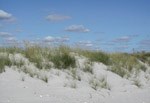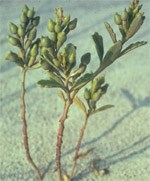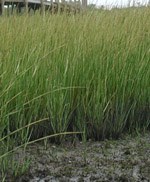
NPS Photo 
NPS Photo In the sheltered zone beyond the dunes where fresh water is more plentiful, vegetative cover jumps to 80% and is predominantly characterized by less salt-tolerant shrubs, thickets and wildflowers. Here, taller plants undergo a natural pruning process, as salt winds blowing over the dunes limit their height. Common species in these areas include wax myrtle (Myrica cerifera) and northern bayberry (Myrica pensylvanica), which provide food and cover for songbirds, small rodents, and rabbits. Other species commonly found among the shrub thickets include blackberry (Rubus argutus) and poison ivy (Toxicodendron radicans). Where the island is wide enough to allow sufficient protection from the ocean's salt spray and overwash, trees are able to establish a foothold. The forests of Assateague are predominantly pine woodlands, with loblolly pine (Pinus taeda) being the most prevalent tree species. Scrub pine (Pinus virginiana), greenbrier (Smilax rotundifolia), and muscadine grape (Vitis rotunifolia) are also common in the forest understory. 
NPS Photo On the mainland side of the island adjacent to the bay, one can find large areas of salt marsh dominated by salt marsh cordgrass (Spartina alterniflora), a plant that has adapted to periodic flooding by seawater by releasing salt through its leaves. Within the waters of the bay itself, beds of eel grass (Zostera marina)and other submerged aquatic vegetation provide shelter and spawning areas for aquatic animals, while microscopic phytoplankton produces vast amounts of oxygen. The plant life of Assateague and its surrounding waters mirrors the rich diversity of its habitats, playing a variety of vital roles in the island ecosystem. |
Last updated: June 5, 2021
